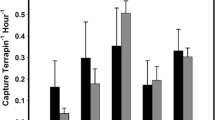Abstract
Diamondback terrapins (Malaclemys terrapin) drown in blue crab (Callinectes sapidus) pots throughout their range. The objectives of this study were to test if bycatch mortality of diamondback terrapins in commercial crab pots is reduced by using bycatch reduction devices (BRDs) and to determine if BRDs affect crab catch in Florida by comparing sex, size, and number of blue crabs captured in standard crab pots with those captured in pots equipped with BRDs. We fished 15 standard crab pots (controls) and 15 crab pots with bycatch reduction devices (experimentals) for 10-d periods at two sites per year from 2002 through 2005. Study sites were located in eight Florida counties with one sample period per county. Pots were checked daily and baited on alternate days. We determined sex and size of captured terrapins and blue crabs to evaluate if BRDs affected the size of either species. Thirty-seven terrapins were caught in control pots and four in experimentals. Eleven terrapins were small enough that they would not have been prevented from entering either pot treatment, but we found that 73.2% of the terrapins in this study could have been prevented from entering crab pots with functional BRDs. There were no significant differences between the sex, measurements, or number of legal-sized crabs captured in control and experimental pots at any of the study sites. We recommend that the Florida Fish and Wildlife Conservation Commission devise and adopt regulations that require the use of 4.5×12 cm BRDs on all commercial and recreational crab pots in Florida without delay.
Similar content being viewed by others
Literature Cited
Bishop, J. M. 1983. Incidental capture of diamondback terrapins by crab pots.Estuaries 6:426–430.
Burger, J. 1989. Diamondback terrapin protection.Plastron Papers 19:35–40
Butler, J. A. 2000. Status and distribution of the Carolina diamondback terrapin,Malaclemys terrapin centrata, in Duval County. Florida Fish and Wildlife Conservation Commission, Tallahassee, Florida.
Butler, J. A. 2002. Population ecology, home range, and seasonal movements of the Carolina diamondback terrapin,Malaclemys terrapin centrata, in northeastern Florida. Florida Fish and Wildlife Conservation Commission, Tallahassee, Florida.
Butler, J. A., G. L. Heinrich, andR. A. Seigel. 2006. Third workshop on the ecology, status, and conservation of diamondback terrapins (Malaclemys terrapin): Results and recommendations.Chelonian Conservation and Biology 5:331–334.
Cole, R. V. andT. E. Helser. 2001. Effect of three bycatch reduction devices on diamondback terrapinMalaclemys terrapin capture and blue crabCallinectes sapidus harvest in Delaware Bay.North American Journal of Fisheries Management 21:825–833.
Davis, C. C. 1982. A study of the crab pot as a fishing gear. Publication Number 53. Chesapeake Biological Laboratory, Solomons, Maryland.
Ernst, C. H., J. E. Lovich, andR. W. Barbour. 1994. Turtles of the United States and Canada. Smithsonian Institution Press, Washington, D.C.
Guillory, V. andP. Prejean. 1998. Effect of a terrapin excluder device on blue crab,Callinectes sapidus, trap catches.Marine Fisheries Review 60:38–40.
Hipes, D., D. R. Jackson, K. Nesmith, D. Printiss, andK. Brandt. 2001. Field Guide to the Rare Animals of Florida. Florida Natural Areas Inventory, Tallahassee, Florida.
Hoyle, M. E. andJ. W. Gibbons. 2000. Use of a marked population of diamondback terrapins (Malaclemys terrapin) to determine impacts of recreational crab pots.Chelonian Conservation and Biology 3:735–737.
Lovich, J. E. andJ. W. Gibbons. 1990. Age at maturity influences adult sex ratio in the turtleMalaclemys terrapin.Oikos 59:126–134.
Mann, T. M. 1995. Population surveys for diamondback terrapins (Malaclemys terrapin) and Gulf salt marsh snakes (Nerodia clarkii clarkii) in Mississippi. Mississippi Museum of Natural Science Technical Report Number 37, Jackson, Mississippi.
Marion, K. R. 1986. Mississippi diamondback terrapin, p. 52–53.In R. H. Mount (ed.), Vertebrate Animals of Alabama in Need of Special Attention. Alabama Agricultural Experiment Station, Auburn University, Auburn, Alabama.
Mazzarella, A. D. 1994. Test of a turtle exclusion device in commercial crab pots. New Jersey Division of Fish and Game, Port Republic, New Jersey.
Roosenburg, W. M. 1991. The diamondback terrapin: Population dynamics, habitat requirements, and opportunities for conservation, p. 227–234.In A. Chaney and J. Mihursky (eds.), Proceedings of a Conference: New Perspectives in the Chesapeake System: A Research and Management Partnership Publication Number 137. Chesapeake Research Consortium, Solomons, Maryland.
Roosenburg, W. M. 2004. The impact of crab pot fisheries on terrapin (Malaclemys terrapin) populations: Where are we and where do we need to go?, p. 23–30.In C. W. Swarth, W. M. Roosenburg, and E. Kiviat (eds.), Conservation and Ecology of Turtles of the Mid-Atlantic Region: A Symposium. Bibliomania! Salt Lake City, Utah.
Roosenburg, W. M., W. Cresko, M. Modesitte, andM. B. Robbins. 1997. Diamondback terrapin (Malaclemys terrapin) mortality in crab pots.Conservation Biology 11:1166–1172.
Roosenburg, W. M. andJ. P. Green. 2000. Impact of a bycatch reduction device on diamondback terrapin and blue crab capture in crab pots.Ecological Applications 10:882–889.
Seigel, R. A. 1984. Parameters of two populations of diamondback terrapins (Malaclemys terrapin) on the Atlantic coast of Florida, p. 77–87.In R. A. Seigel, L. E. Hunt, J. L. Knight, L. Maralet, and N. L. Zuschlag (eds.), Vertebrate Ecology and Systematics—A Tribute to Henry S. Fitch. Museum of Natural History, University of Kansas, Lawrence, Kansas.
Wood, R. C. 1997. The impact of commercial crab traps on northern diamondback terrapins,Malaclemys terrapin terrapin, p. 21–27.In J. Van Abbema (ed.), Proceedings: Conservation, Restoration, and Management of Tortoises and Turtles—An International Conference. New York Turtle and Tortoise Society, New York.
Wood, R. C. andR. Herlands. 1996. Terrapins, tires and traps: Conservation of the northern diamondback terrapin (Malaclemys terrapin terrapin) on the Cape May Peninsula, New Jersey, USA, p. 254–256.In Proceedings of the International Congress of Chelonian Conservation. SOPTOM, Gonfaron, France.
Author information
Authors and Affiliations
Corresponding author
Rights and permissions
About this article
Cite this article
Butler, J.A., Heinrich, G.L. The effectiveness of bycatch reduction devices on crab pots at reducing capture and mortality of diamondback terrapins (Malaclemys terrapin) in Florida. Estuaries and Coasts: J ERF 30, 179–185 (2007). https://doi.org/10.1007/BF02782978
Received:
Revised:
Accepted:
Issue Date:
DOI: https://doi.org/10.1007/BF02782978




